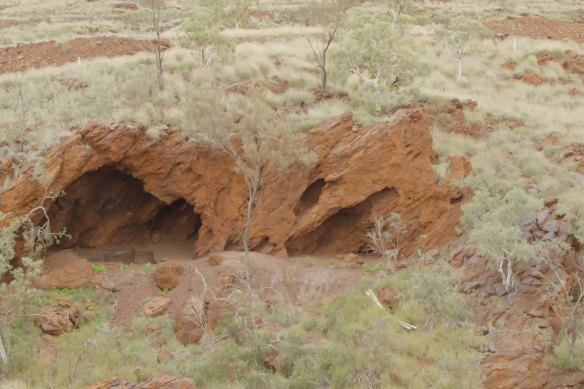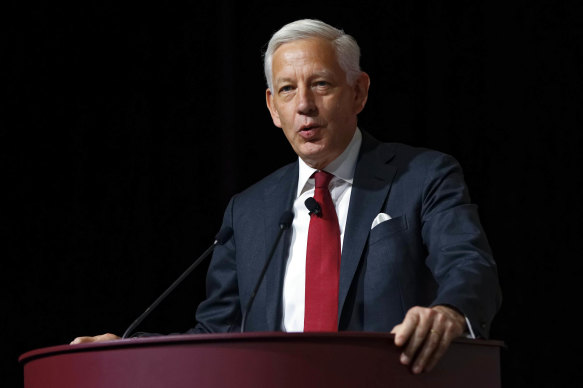By Nick Toscano
Rio Tinto chairman Dominic Barton has described the destruction of the 46,000-year-old Juukan Gorge rock shelters three years ago as a “deep stain” on the mining giant’s history as the site’s traditional owners reflect on their loss and the ongoing impact of the disaster.
Wednesday marked the third anniversary of explosives charges being detonated at the ancient and culturally significant site in Western Australia’s Pilbara region to make way for an expansion of Rio Tinto’s Brockman 4 iron ore mine.

The rock shelters at Juukan Gorge had evidence of continual human occupation tracing back at least 46,000 years, placing them among the most significant archaeological sites in Australia.Credit: PKKP Aboriginal Corporation
“It’s something that I am deeply, deeply apologetic for, and something that is a deep stain on our history that we have to deal with,” Barton said.
Barton was appointed Rio Tinto’s chairman at its annual shareholder meeting last year after his predecessor, Simon Thompson, stood down over the Juukan Gorge disaster.
Rio Tinto’s decision to blast through the site, although legally sanctioned, went against the wishes of its traditional owners, who said they were not aware of the company’s intention to destroy the site until it was too late for the explosive charges to be removed. It unleashed global condemnation, triggered a federal parliamentary inquiry and plunged the mining giant into crisis.
An uprising by Rio Tinto’s biggest shareholders in Australia and Britain eventually forced the resignations of its former chief executive, Jean-Sebastien Jacques, other executives and members of the board.

“It’s something that I am deeply, deeply apologetic for”: Rio Tinto chairman Dominic Barton.Credit: Trevor Collens
Although Rio Tinto claimed it believed it had the traditional owners’ consent until it was too late to stop the blast safely, the miner has issued public apologies and has acknowledged failures in its communication that could have prevented the debacle.
Barton and Rio Tinto’s new chief executive, Jakob Stausholm, have made restoring trust with First Nations communities and improving cultural heritage processes top priorities, and have travelled to the Pilbara to meet the traditional owners, the Puutu Kunti Kurrama and Pinikura (PKKP) people.
“It’s deeply felt within the organisation, and I think we’ve got to use that to move us institutionally forward,” Barton told The Australian Financial Review’s mining summit on Wednesday.
The PKKP Aboriginal Corporation said it was a sad day marking a “devastating loss” that would never be recovered.
“The destruction of our most significant cultural heritage site should not have happened,” PKKP Land Committee chairperson Burchell Hayes said.
Although the traditional owners’ loss could “never be recovered”, Hayes said remediation works were beginning to take shape.
Recent rehabilitation activities included seeding and replanting the area to revegetate the Juukan Gorge landscape with native plants, the PKKP said.
The traditional owners have sought a co-management agreement with Rio Tinto that would give them a greater say over future works on their ancestral lands.
“To ensure that we will never experience this senseless feeling of loss and devastation in the future, we are driven towards achieving a co-management process of Country with mining companies,” Hayes said.
“We have already started to see minor aspects of the co-management model working at Juukan Gorge, through rehabilitation works of some of the surrounding areas.”
Ancient artefacts unearthed at the Juukan Gorge shelters – including grinding and pounding stones, a 28,000-year-old marsupial bone sharpened into a tool and a 4000-year-old belt made of plaited human hair with DNA linking it directly to today’s PKKP people – had placed the caves among the most significant archaeological research sites in Australia as the only site to show evidence of continual human occupation through the last Ice Age.
“We have always said that we are not opposed to mining, but it needs to be done in the right way, involving traditional owners, and first of all, gaining our free, prior and informed consent,” Hayes said.
The Business Briefing newsletter delivers major stories, exclusive coverage and expert opinion. Sign up to get it every weekday morning.